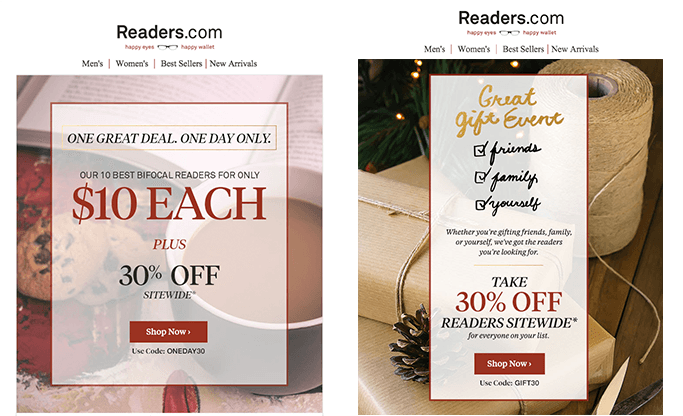Randy Stocklin co-founded One Click along with his wife Angie, and serves as its Chief Executive Officer. Randy is responsible for the overall leadership and strategic direction of One Click along with their three Ecommerce eyewear brands; felix + iris, Readers.com and Sunglass Warehouse.
We’re halfway through the first quarter of 2016. There are more wreaths on the streetlights, no more carols on the radio. Why put ourselves through one more conversation about “Black Friday,” “Cyber Monday,” and “Holiday-Only Specials”? Why not just move on to Valentine’s Day and the Spring Collections and let the calendar carry us into the next phase in our marketing plans?
Because this is the time we can look back as a marketing team to get the best sense of how things went during the hectic holiday season – to see what worked beautifully, what could have gone better, what we should keep doing year after year, and what we absolutely need to avoid. The following are our top five marketing takeaways from the 2015 holiday season:
1. Manage Expectations for Deliverables in Customer-Facing Communication
Last year, we invested two years of warehouse and inventory management budget on a bin system, designed to replace the one that had just expanded organically from the living room where One Click started to our current 14’6” tall warehouse space. The results have exceeded our expectations and dramatically increased the speed and accuracy of our fulfillment team.
Going into the 2015 holiday season, we knew that we’d be able to pack and ship faster than previous years (at lower overall seasonal employment cost) and that we could count on the speed without worrying about increasing error. We’re absolutely confident that we can always meet or break our internal fulfillment deadlines. But our company holiday schedule may delay orders placed after the holiday shipping deadline. It’s important to us to keep a small business-style, family-friendly calendar. That means a Thursday or Friday Christmas creates a 4-day block where no shipments get processed. This year, for instance, orders placed after 2pm on December 23rd did not ship until the 28th.
This is vital to communicate clearly to our customers. We need to make that deadline and the reasons behind it absolutely clear up front. We also need to make it clear that during peak shipping times such as Cyber Monday, deliveries may be delayed by the sheer volume of packages ordered on Black Friday. Those delays may be wholly out of our control, but if we can manage our customers’ expectations early enough in the process – delineate precisely the cutoff date for any holiday delivery guarantees, and exactly what length of delay might result from missing that deadline – we should be able to mitigate the potential level of disappointment.
Marketer Tip: If you can predict how your customers will behave in the future or mine past behavior for actionable trends, you may be able to use your marketing to stave off problems in operations that would otherwise slow them down during peak sales seasons.
2. Use Deadlines as a Motivating Factor for Customers
It’s no secret that consumers react to the idea of losing something (an opportunity, for instance) more reliably than they react to the chance to gain something. Like a lot of retailers, then, we build a sense of urgency into our marketing output. Sales “end soon,” “won’t be around forever,” and so forth. But we also see that the more reason we give for that deadline to be concrete – the more it’s tied to some specific calendar day, for instance – the more likely our audience is to engage with the opportunity.Take the two Q4 emails below, for instance. They were sent at similar points in our discount cycle, under similar conditions. It isn’t exactly the ideal A/B test, but the scenario is very representative of big picture trends in our email relationships.
- One Great Deal. One Day Only. — Our 10 Best Bifocal Readers for Only $10 Each.
- Great Gift Event. — Friends. Family. Yourself.
Version 1 is urgency-driven whereas Version 2 is driven by other indirect messaging. Version 1 outperformed Version 2 in terms of open rate (1.5% higher), click-through rate (214% higher), and overall revenue (260% higher). This upcoming year we plan to make use of that learning and use the honest, natural urgency of shipping deadlines to reinforce the idea that chances are slipping away – especially during the holidays. Not because we’re choosing to eliminate the opportunity any sooner, but because we stand to gain more by emphasizing the fact that the opportunity ends. We’re not changing the facts underlying the message, only how we frame them.
Marketer Tip: Give your customers an opportunity with a finite end. And make sure that end is communicated consistently across all touchpoints. Your message is much more likely to elicit the response you’re looking for if the customer actually believes that there is value slipping away.
3. Prepare an Apology Package Before You Need One
While improvements in process and infrastructure help guarantee that we do our part to deliver on time, shipping delays are inevitable. So, we’re going into the 2016 holidays with an apology package in place – most likely an apology letter appropriate to each brand and a discount on a subsequent purchase. We’re also going to track the long term value of customer relationships in which the apology package has been triggered to see whether it mitigates the situation, or better yet, increases long-term value above what we can expect in an average customer whose holiday order has not been delayed.
Marketer Tip: No matter what business you’re in or how savvy you are when it comes to customer service, you’re likely to run into a situation where you have unhappy customers. It’s a problem that applies to all divisions in an organization, but it’s an opportunity for marketing to take the lead. Be prepared ahead of time, and marketing will be able to turn a problem into an opportunity.
4. Test Marketing Calendars that Adapt to Changes in the Buying Cycle
In 2015, we pushed out Cyber Tuesday messaging as part of a wholly separate sales holiday. In past years we had only relied on residual sales from Cyber Monday. We knew there would be shoppers who were still looking for deals, and we expected to make sales from emails extending the holiday. In 2014, using that strategy, we matched 40% of the sales from the day before.
This year, though, we reiterated the same discount to our email list then used the urgency of a novel shopping opportunity to drive sales. It worked beautifully, and turned out to match 70% of Cyber Monday’s total sales volume.
Marketer Tip: This is vital to a thriving marketing team. Using the same plan year after year without innovation is likely to lead to missed opportunities, and may even cause sales to underperform. Take a look at your past performance. See what has room for improvement, and iterate on solutions.
5. Sales Peaks Flatten. Plan Accordingly
As with a lot of retail businesses, we’re seeing a long-term trend to flatten out what used to be a couple of peak December weekends into something more like a month-long hill. If we wait until Thanksgiving to start pushing holiday-related sales, we are definitely missing out on some of the consumer dollars spent earlier in the month. This year, we’ll do some A/B testing with new schedules for pre-holiday sends. We’ll also iterate on messaging with various degrees of emphasis on specific, themed pre-holiday messaging or non-holiday related messaging that happens to run at that point in the calendar.
Marketer Tip: Keep an eye on big picture national and seasonal trends. If you see a tendency in the buying public as a whole, it’s much more effective to anticipate the long-term changes, rather than continually underperforming based on outdated goals.
All in all, we’re pretty excited by what we’ve learned. It’s given us the chance to prepare in a way that will strengthen our customer relationships during the holidays, and that will ultimately make us a stronger, more capable force in the marketplace year-round.






